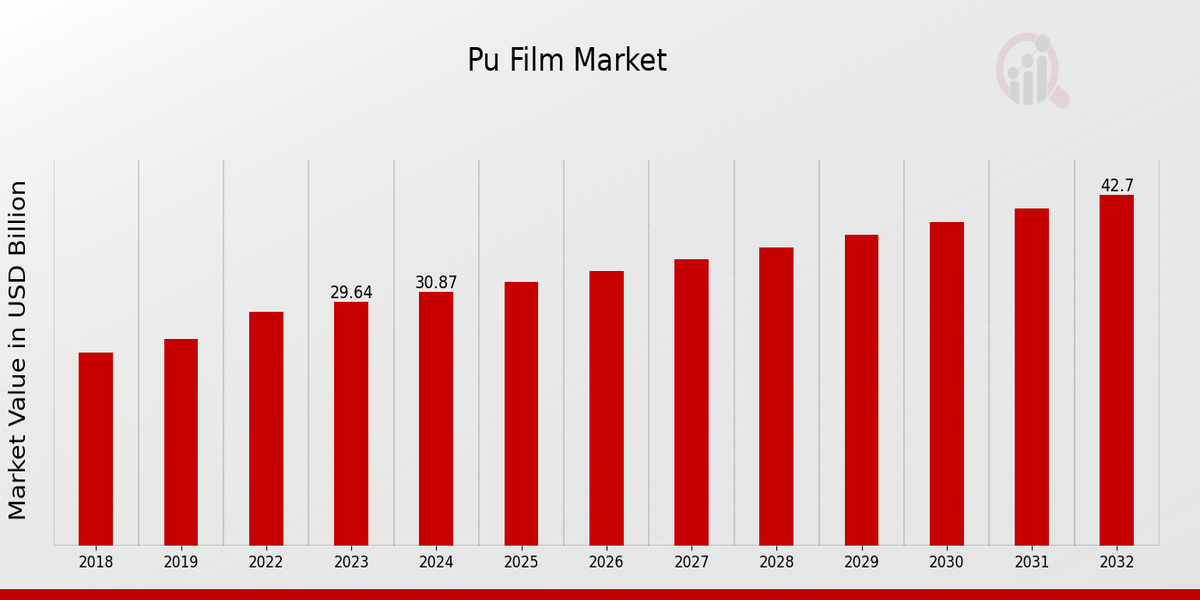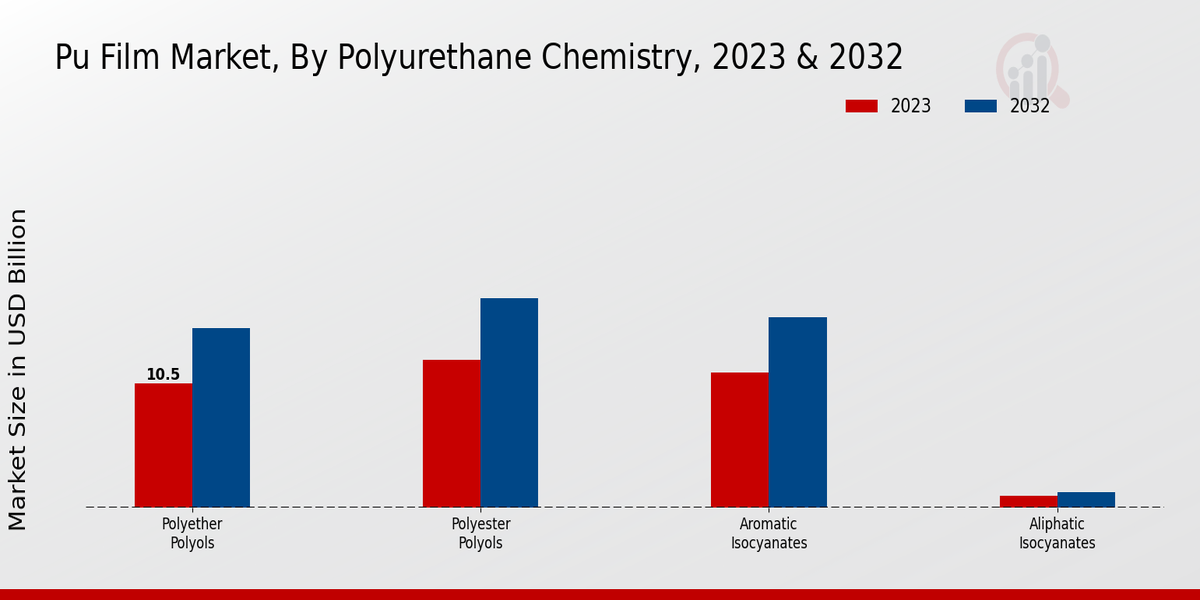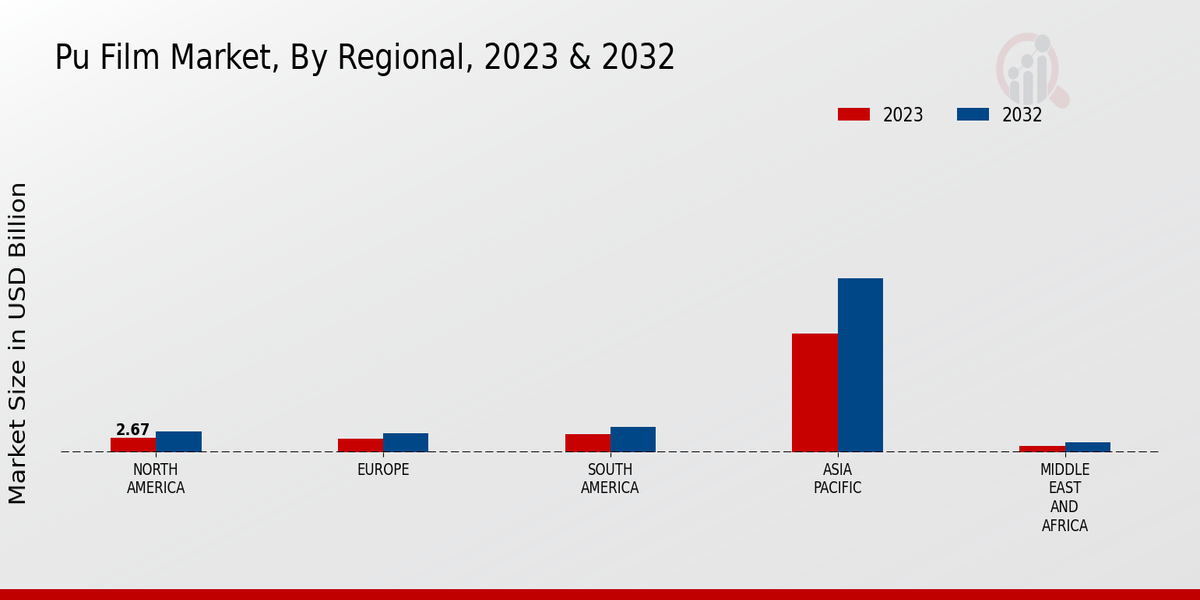Global Pu Film Market Overview
The Pu Film Market Size was estimated at 32.14(USD Billion) in 2024.The Pu Film Industry is expected to grow from 33.48(USD Billion) in 2025 to 48.24(USD Billion) by 2034. The Pu Film Market CAGR (growth rate) is expected to be around 4.10% during the forecast period (2025 - 2034).
Key Pu Film Market Trends Highlighted
Key Market Drivers:Rising demand for lightweight and durable materials in the automotive and construction industries, a growing preference for biodegradable and environmentally friendly packaging, increasing use in medical devices, and advancements in printing technologies for decorative applications.Opportunities to be Explored:Expanding applications in electronics, healthcare, and consumer goods, untapped potential in emerging economies, development of new and innovative grades of PU film with improved properties, and collaborations with manufacturers for customized solutions.Recent Trends:Increasing focus on sustainability and the adoption of bio-based and biodegradable materials, growing demand for high-barrier films for food packaging, advancements in nanocomposite films for enhanced performance, and the emergence of smart and functional PU films with self-cleaning, antimicrobial and sensor capabilities.
 Source: Primary Research, Secondary Research, MRFR Database and Analyst Review
Pu Film Market Drivers
Source: Primary Research, Secondary Research, MRFR Database and Analyst Review
Pu Film Market Drivers
Growing Demand for Flexible and Transparent Electronics
The increasing adoption of flexible and transparent electronics in various industries is driving the growth of the Pu Film Market. These electronics find applications in smartphones, tablets, wearable devices, and automotive displays. The demand for flexible and transparent electronics is expected to continue to rise as these devices become more prevalent and sophisticated. Pu Film is a key material used in the production of these electronics due to its excellent optical clarity, flexibility, and durability.The growing demand for flexible and transparent electronics is therefore expected to create significant opportunities for growth in the Pu Film market. The Pu Film Market Industry is expected to grow from USD 29.64 billion in 2023 to USD 42.7 billion by 2032, at a CAGR of 4.14%. Asia-Pacific is expected to hold the largest market share during the forecast period due to the increasing demand for flexible and transparent electronics in the region.
Rising Demand for Pu Film in the Automotive Industry
The increasing demand for Pu Film in the automotive industry is another major factor driving the growth of the Pu Film Market. Pu Film is used in automotive applications such as interior trim, seat covers, and headliners. The demand for Pu Film in the automotive industry is expected to continue to rise as consumers demand more comfortable and stylish vehicles. The Pu Film Market Industry is expected to grow from USD 29.64 billion in 2023 to USD 42.7 billion by 2032, at a CAGR of 4.14%.Asia-Pacific is expected to hold the largest market share during the forecast period due to the increasing demand for flexible and transparent electronics in the region.
Increasing Use of Pu Film in Medical Applications
The increasing use of Pu Film in medical applications is also contributing to the growth of the Pu Film Market. Pu Film is used in medical applications such as wound dressings, surgical gowns, and medical devices. The demand for Pu Film in medical applications is expected to continue to rise as the healthcare industry adopts more advanced and innovative technologies. The Pu Film Market Industry is expected to grow from USD 29.64 billion in 2023 to USD 42.7 billion by 2032, at a CAGR of 4.14%.Asia-Pacific is expected to hold the largest market share during the forecast period due to the increasing demand for flexible and transparent electronics in the region.
Pu Film Market Segment Insights
Pu Film Market Polyurethane Chemistry Insights
The Pu Film Market is segmented into various categories, with polyurethane chemistry being a crucial one. This segment encompasses a range of chemical components used in the production of Pu films, including polyether polyols, polyester polyols, aromatic isocyanates, and aliphatic isocyanates. Polyether polyols, with their flexible molecular structure, offer excellent mechanical properties and resistance to hydrolysis, making them suitable for applications in automotive interiors, footwear, and wire and cable insulation. Polyester polyols, on the other hand, provide enhanced chemical resistance and thermal stability, catering to applications in packaging, construction, and industrial coatings.Aromatic isocyanates, such as toluene diisocyanate (TDI) and methylene diphenyl diisocyanate (MDI), are widely used in the production of flexible and rigid Pu films due to their low cost and high reactivity. Aliphatic isocyanates, like hexamethylene diisocyanate (HDI) and isophorone diisocyanate (IPDI), offer improved UV resistance and reduced toxicity, making them preferred for applications in outdoor environments and medical devices. The Pu Film Market revenue for polyurethane chemistry is projected to reach $12.5 billion by 2023, driven by increasing demand for Pu films in diverse industries.The automotive sector, with its focus on lightweight and durable materials, is a major consumer of Pu films, particularly for interior components and seating. The construction industry also presents significant growth opportunities, as Pu films offer insulation, waterproofing, and acoustic damping properties in roofing, flooring, and wall systems. The Pu Film Market segmentation provides insights into the dynamics and growth potential of specific market segments, enabling manufacturers to tailor their strategies and target specific applications.By leveraging this data, industry players can optimize their product offerings, identify emerging trends, and gain a competitive edge in the rapidly evolving Pu film market.
 Source: Primary Research, Secondary Research, MRFR Database and Analyst Review
Pu Film Market Film Type Insights
Source: Primary Research, Secondary Research, MRFR Database and Analyst Review
Pu Film Market Film Type Insights
The Film Type segment of the Pu Film Market is classified into Pure PU Film, Breathable PU Film, Anti-static PU Film, Flame Retardant PU Film, and Anti-slip PU Film. Among these, Pure PU Film holds the largest market share due to its exceptional properties, such as high tensile strength, flexibility, and resistance to chemicals and abrasion. In 2023, the Pu Film Market revenue for Pure PU Film was valued at 12.97 Billion USD and is projected to reach 19.14 Billion USD by 2032, exhibiting a CAGR of 4.65%. Breathable PU Film, with its moisture-wicking and air-permeable characteristics, is gaining significant traction in the healthcare and hygiene industries.The Anti-static PU Film segment is expected to witness substantial growth owing to its ability to dissipate static charges, making it suitable for applications in electronics and packaging. Flame Retardant PU Film, due to its fire-resistant properties, is witnessing increasing demand in the construction and transportation industries. Anti-slip PU Film, with its enhanced traction and grip, is gaining popularity in flooring and safety applications. These specialized Film Types cater to specific industry requirements, driving the overall growth of the Pu Film Market.
Pu Film Market Application Insights
The application segment of the Pu Film Market plays a significant role in driving market growth. Packaging Coating, Medical Pharmaceutical, Automotive Transportation, Consumer Goods, Electronics, and Industrial applications each contribute unique market dynamics and growth opportunities. In 2023, the market is expected to surpass 29.64 USD Billion, with projections to reach 42.7 USD Billion by 2032. Packaging Coating: This segment accounted for the largest revenue share in 2023, owing to the extensive use of PU films in packaging solutions, protective coatings, and graphic arts.Medical Pharmaceutical: The demand for PU films in medical devices, drug delivery systems, and wound care is expected to drive segment growth. Automotive Transportation: The increasing adoption of lightweight materials in vehicles to enhance fuel efficiency is boosting the demand for PU films. Consumer Goods Electronics: PU films find application in household appliances, electronic devices, and various consumer products due to their durability and aesthetic appeal. Industrial: PU films are utilized in industrial applications such as filtration, insulation, and protective coverings, contributing to the segment's growth.The Pu Film Market segmentation provides valuable insights into market opportunities and challenges. Understanding the diverse application segments and their growth potential allows stakeholders to make informed decisions and capitalize on emerging trends.
Pu Film Market End-Use Industry Insights
The end-use industry segment of the Pu Film Market is diverse, with various industries utilizing PU films for a range of applications. In 2023, the Pu Film Market for Agriculture was valued at USD 3.2 billion and is projected to reach USD 4.6 billion by 2032, growing at a CAGR of 4.2%. The Construction segment held a significant share of the market in 2023, valued at USD 4.1 billion, and is anticipated to expand to USD 5.9 billion by 2032, exhibiting a CAGR of 4.5%. The Automotive industry's PU film market was estimated at USD 2.8 billion in 2023 and is expected to grow to USD 4.0 billion by 2032, with a CAGR of 4.3%.The Healthcare segment, valued at USD 2.5 billion in 2023, is projected to reach USD 3.6 billion by 2032, growing at a CAGR of 4.4%. The Electronics industry's PU film market was valued at USD 2.2 billion in 2023 and is anticipated to expand to USD 3.1 billion by 2032, with a CAGR of 4.6%. Lastly, the Packaging segment, valued at USD 2.1 billion in 2023, is expected to grow to USD 3.0 billion by 2032, with a CAGR of 4.5%. These industry segments represent significant growth opportunities for PU film manufacturers, driven by increasing demand for lightweight, flexible, and durable materials across various end-use industries.
Pu Film Market PU Film Raw Materials Insights
The Pu Film Market is segmented into raw materials, including polyols, isocyanates, additives, and catalysts. Polyols are the largest segment, accounting for over 50% of the market in 2023. Isocyanates are the second-largest segment, followed by additives and catalysts. The growth of the market is driven by the increasing demand for PU films in various applications, such as automotive, construction, and packaging. Polyols are the most important raw material used in the production of PU films. They are responsible for the film's flexibility and toughness.Isocyanates are also essential raw materials, as they react with polyols to form the urethane bond that gives PU films their strength. Additives and catalysts are used to improve the properties of PU films, such as their resistance to heat and UV light.
Pu Film Market Regional Insights
The regional segmentation of the Pu Film Market market offers valuable insights into the geographical distribution of the market and its potential growth opportunities. North America is anticipated to dominate the market with a significant share of the Pu Film Market revenue, driven by the strong presence of automotive and packaging industries in the region. Europe, with its stringent regulations and focus on sustainability, is expected to hold a noteworthy share of the market, showcasing the growing adoption of Pu Film in various applications.The APAC region, particularly China and India, exhibits significant growth potential due to the expanding construction and electronics sectors. South America and MEA are anticipated to witness steady growth in the coming years, presenting opportunities for market expansion.
 Source: Primary Research, Secondary Research, MRFR Database and Analyst Review
Pu Film Market Key Players And Competitive Insights
Source: Primary Research, Secondary Research, MRFR Database and Analyst Review
Pu Film Market Key Players And Competitive Insights
Major players in Pu Film Market industry are constantly striving to gain a competitive edge by investing in research and development, expanding their product portfolios, and strengthening their distribution networks. Leading Pu Film Market players are focusing on developing innovative products that meet the evolving needs of customers. They are also investing in capacity expansion to cater to the growing demand for Pu Film Market. The Pu Film Market Competitive Landscape is characterized by intense competition among established players and emerging entrants. Key players are adopting various strategies such as mergers and acquisitions, partnerships, and collaborations to strengthen their market position.DuPont is a leading company in the Pu Film Market industry. The company offers a wide range of Pu Film Market products, including films for automotive, electronics, and packaging applications. DuPont is known for its strong brand reputation, extensive distribution network, and commitment to innovation. The company has a global presence and operates manufacturing facilities in several countries. DuPont is continuously investing in research and development to improve its products and processes. The company is also actively involved in mergers and acquisitions to expand its product portfolio and geographical reach.3M is a major competitor in the Pu Film Market industry. The company offers a diverse range of Pu Film Market products, including films for automotive, electronics, and healthcare applications. 3M is known for its strong product innovation capabilities, global presence, and extensive distribution network. The company has a strong focus on research and development and invests heavily in new product development. 3M is also actively engaged in mergers and acquisitions to expand its product portfolio and geographical reach. The company has a strong commitment to sustainability and is working to reduce its environmental footprint.
Key Companies in the Pu Film Market Include
- Dow Chemical Company
- JSR Corporation
- Lubrizol
- DIC Corporation
- Sumitomo Chemical Company
- Kuraray
- Hitachi Chemical
- Asahi Kasei
- Toray Industries
- Huntsman Corporation
- Evonik Industries
- BASF
- Teijin Limited
- Mitsubishi Gas Chemical Company
- Covestro
Pu Film Market Industry Developments
Growth in the automotive and construction industries is a key driver of this market. PU films are used in a variety of automotive applications, such as interior trim, seating, and headliners. They are also used in construction applications, such as roofing, flooring, and wall coverings. Rising demand for lightweight and durable materials in these industries is expected to continue to drive market growth.Recent news developments in the Pu Film Market include: In January 2023, Covestro announced the launch of a new range of PU films for automotive applications. The new films are designed to meet the increasing demand for lightweight and durable materials in the automotive industry. In March 2023, BASF announced the expansion of its PU film production capacity in Asia. The expansion is expected to meet the growing demand for PU films in the region. In May 2023, Huntsman Corporation announced the acquisition of Icynene-Lapolla, a leading manufacturer of PU foam insulation and roofing systems. The acquisition is expected to strengthen Huntsman's position in the PU film market.
Pu Film Market Segmentation Insights
-
Pu Film Market Polyurethane Chemistry Outlook
- Polyether Polyols
- Polyester Polyols
- Aromatic Isocyanates
- Aliphatic Isocyanates
-
Pu Film Market Film Type Outlook
- Pure PU Film
- Breathable PU Film
- Anti-static PU Film
- Flame Retardant PU Film
- Anti-slip PU Film
-
Pu Film Market Application Outlook
- Packaging Coating
- Medical Pharmaceutical
- Automotive Transportation
- Consumer Goods Electronics
- Industrial
-
Pu Film Market End-Use Industry Outlook
- Agriculture
- Construction
- Automotive
- Healthcare
- Electronics
- Packaging
-
Pu Film Market PU Film Raw Materials Outlook
- Polyols
- Isocyanates
- Additives
- Catalysts
-
Pu Film Market Regional Outlook
- North America
- Europe
- South America
- Asia Pacific
- Middle East and Africa
| Report Attribute/Metric |
Details |
| Market Size 2024 |
32.14(USD Billion) |
| Market Size 2025 |
33.48(USD Billion) |
| Market Size 2034 |
48.24(USD Billion) |
| Compound Annual Growth Rate (CAGR) |
4.10% (2025 - 2034) |
| Report Coverage |
Revenue Forecast, Competitive Landscape, Growth Factors, and Trends |
| Base Year |
2024 |
| Market Forecast Period |
2025 - 20324 |
| Historical Data |
2020 - 2024 |
| Market Forecast Units |
USD Billion |
| Key Companies Profiled |
Dow Chemical Company, JSR Corporation, Lubrizol, DIC Corporation, Sumitomo Chemical Company, Kuraray, Hitachi Chemical, Asahi Kasei, Toray Industries, Huntsman Corporation, Evonik Industries, BASF, Teijin Limited, Mitsubishi Gas Chemical Company, Covestro |
| Segments Covered |
Polyurethane Chemistry, Film Type, Application, End-Use Industry, PU Film Raw Materials, Regional |
| Key Market Opportunities |
1. Growing demand for artificial leather 2. Increasing application in the automotive industry 3. Technological advancements in PU film production 4. Rising consumer preference for sustainable materials 5. Expanding healthcare sector |
| Key Market Dynamics |
1. Rising demand for automotive 2. increasing investment in infrastructure 3. growing demand from the packaging industry 4. technological advancements 5. expanding consumer electronics market |
| Countries Covered |
North America, Europe, APAC, South America, MEA |
Frequently Asked Questions (FAQ) :
The Pu Film Market was anticipated to reach USD 4.10%billion in 2025.
The Pu Film Market is projected to expand at a CAGR of 4.10% from 2025 to 2034.
The Pu Film Market is expected to reach USD 48.24 billion by 2034.
Asia-Pacific is expected to dominate the Pu Film Market throughout the forecast period.
PU Film finds applications in the automotive, construction, packaging, footwear, and healthcare industries.
Key competitors in the Pu Film Market include Covestro, BASF, Dow, Huntsman, and Evonik.
Rising demand for PU Film in the automotive and construction industries is driving market growth.
Fluctuating raw material prices and environmental concerns pose challenges to market growth.
Sustainability and the development of biodegradable PU Films are emerging trends in the market.
Technological advancements in production processes are anticipated to enhance the efficiency and quality of PU Films.

















